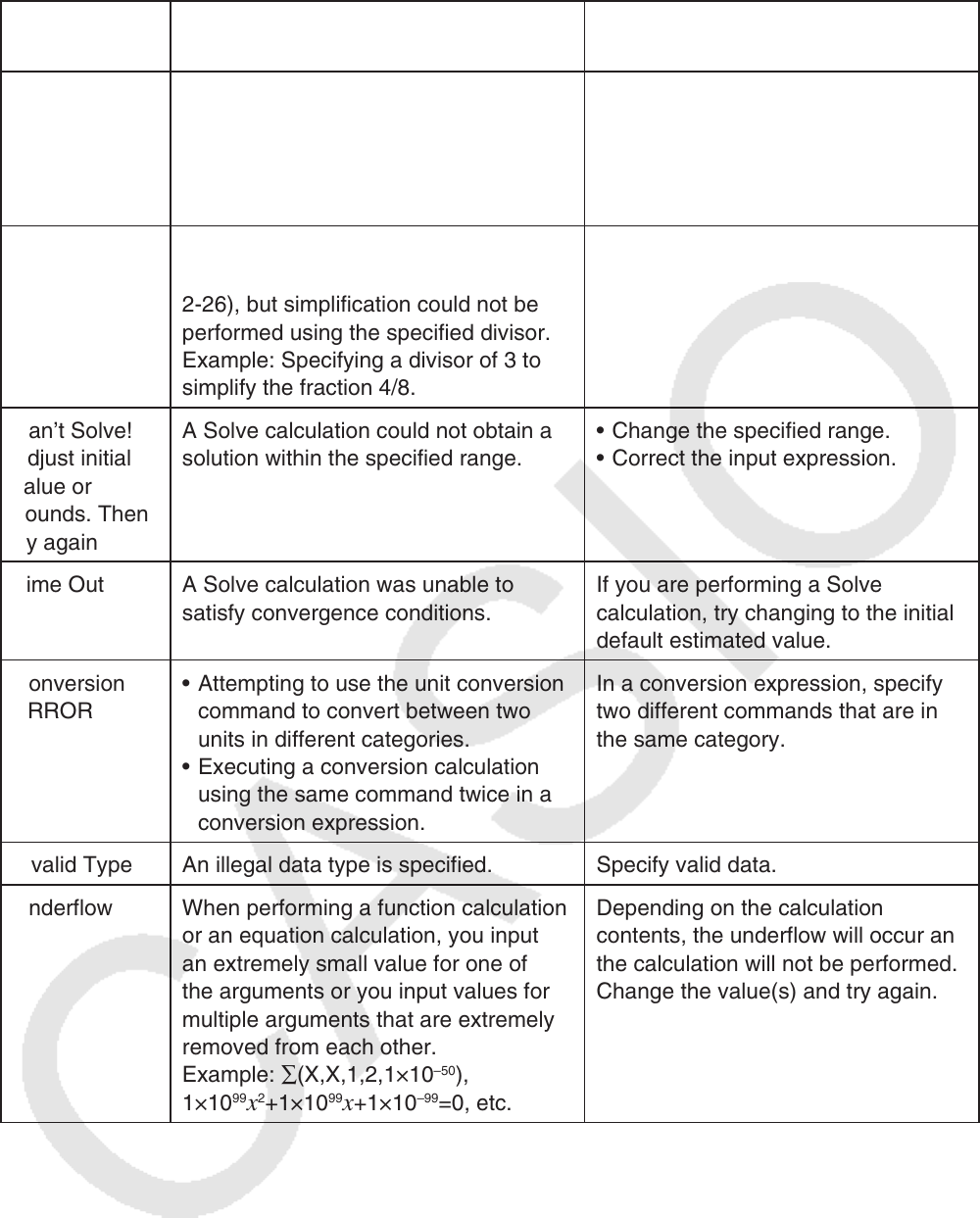User Manual
Table Of Contents
- Contents
- Getting Acquainted — Read This First!
- Chapter 1 Basic Operation
- Chapter 2 Manual Calculations
- 1. Basic Calculations
- 2. Special Functions
- 3. Specifying the Angle Unit and Display Format
- 4. Function Calculations
- 5. Numerical Calculations
- 6. Complex Number Calculations
- 7. Binary, Octal, Decimal, and Hexadecimal Calculations with Integers
- 8. Matrix Calculations
- 9. Vector Calculations
- 10. Metric Conversion Calculations
- Chapter 3 List Function
- Chapter 4 Equation Calculations
- Chapter 5 Graphing
- 1. Sample Graphs
- 2. Controlling What Appears on a Graph Screen
- 3. Drawing a Graph
- 4. Saving and Recalling Graph Screen Contents
- 5. Drawing Two Graphs on the Same Screen
- 6. Manual Graphing
- 7. Using Tables
- 8. Modifying a Graph
- 9. Dynamic Graphing
- 10. Graphing a Recursion Formula
- 11. Graphing a Conic Section
- 12. Drawing Dots, Lines, and Text on the Graph Screen (Sketch)
- 13. Function Analysis
- Chapter 6 Statistical Graphs and Calculations
- 1. Before Performing Statistical Calculations
- 2. Calculating and Graphing Single-Variable Statistical Data
- 3. Calculating and Graphing Paired-Variable Statistical Data (Curve Fitting)
- 4. Performing Statistical Calculations
- 5. Tests
- 6. Confidence Interval
- 7. Distribution
- 8. Input and Output Terms of Tests, Confidence Interval, and Distribution
- 9. Statistic Formula
- Chapter 7 Financial Calculation
- Chapter 8 Programming
- Chapter 9 Spreadsheet
- Chapter 10 eActivity
- Chapter 11 Memory Manager
- Chapter 12 System Manager
- Chapter 13 Data Communication
- Chapter 14 Geometry
- Chapter 15 Picture Plot
- Chapter 16 3D Graph Function
- Appendix
- Examination Mode
- E-CON4 Application (English)
- 1. E-CON4 Mode Overview
- 2. Sampling Screen
- 3. Auto Sensor Detection (CLAB Only)
- 4. Selecting a Sensor
- 5. Configuring the Sampling Setup
- 6. Performing Auto Sensor Calibration and Zero Adjustment
- 7. Using a Custom Probe
- 8. Using Setup Memory
- 9. Starting a Sampling Operation
- 10. Using Sample Data Memory
- 11. Using the Graph Analysis Tools to Graph Data
- 12. Graph Analysis Tool Graph Screen Operations
- 13. Calling E-CON4 Functions from an eActivity

α-2
When you see
this message:
It means this: So you need to do this:
Non-Real
ERROR
Calculation that produces a complex
number when Real is specified for the
Complex Mode setting on the Setup
screen, even though the argument is a
real number.
Change the Complex Mode setting to
something other than Real.
Can’t Simplify Fraction simplification was attempted
using the 'Simp function (page
2-26), but simplification could not be
performed using the specified divisor.
Example: Specifying a divisor of 3 to
simplify the fraction 4/8.
Specify a different divisor or execute
'Simp without specifying any divisor.
Can’t Solve!
Adjust initial
value or
bounds. Then
try again
A Solve calculation could not obtain a
solution within the specified range.
• Change the specified range.
• Correct the input expression.
Time Out A Solve calculation was unable to
satisfy convergence conditions.
If you are performing a Solve
calculation, try changing to the initial
default estimated value.
Conversion
ERROR
• Attempting to use the unit conversion
command to convert between two
units in different categories.
• Executing a conversion calculation
using the same command twice in a
conversion expression.
In a conversion expression, specify
two different commands that are in
the same category.
Invalid Type An illegal data type is specified. Specify valid data.
Underflow When performing a function calculation
or an equation calculation, you input
an extremely small value for one of
the arguments or you input values for
multiple arguments that are extremely
removed from each other.
Example: ∑(X,X,1,2,1
×10
–50
),
1×10
99
x
2
+1×10
99
x+1×10
–99
=0, etc.
Depending on the calculation
contents, the underflow will occur and
the calculation will not be performed.
Change the value(s) and try again.










